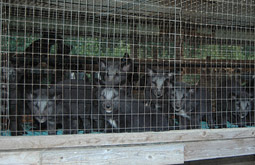Shy wild animals held in mass production facilities
Annually, the fur industry breeds and kills more than 65 million animals worldwide. Many of these animals are held on fur farms. Fur animals are wild animals. Such animals require nature-near and species-appropriate living conditions. In fur production, however, what counts is the fur and not the animal. The following overview provides insight into the suffering of animals bred and held for the fur industry. Please find a detailed description of the holding problems of individual fur animals here.
Living on wire cage floors leads to painful injuries and deformations of the paws. A lack of movement and biological stimuli lead to circulation problems and behavioral disturbances (e.g. stereotypical walking back and forth and biting of the tail).
For animals that occupy extensive territories in nature, a lack of exercise or possibilities to hide is particularly agonizing. Animals used to living close to water such as minks and nutrias suffer from the lack of a possibility to swim.
-
Because most fur animals live solitarily, being forced to live together with thousands of other animals and the corresponding noise and smell are sources of permanent stress.
Mass animal holding under precarious hygienic conditions make the animals susceptible to diseases. This often makes the regular use of medication and growth stimulants necessary.
Often enough, the survival of the animal population can only be ensured by disinfecting the entire farm. The chemicals used as well as the high concentration of feces and urine burden soil and water.
The animals are fed with a mash of slaughter and fish waste. Often, such waste contains the cadavers of skinned animals. This non-species-appropriate feeding (minks, polecats, raccoon dogs, and foxes are predators with corresponding sets of teeth) leads to illnesses and renders natural feeding behavior impossible.

